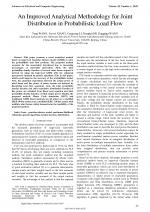| 1/2020 - 7 |
An Improved Analytical Methodology for Joint Distribution in Probabilistic Load FlowWANG, T. |
| Extra paper information in |
| Click to see author's profile in |
| Download PDF |
Author keywords
gaussian mixture model, maximum likelihood estimation, genetic algorithm, density function, distribution
References keywords
power(27), probabilistic(19), flow(17), system(14), load(14), tpwrs(11), systems(8), method(7), wind(6), research(5)
Blue keywords are present in both the references section and the paper title.
About this article
Date of Publication: 2020-02-28
Volume 20, Issue 1, Year 2020, On page(s): 49 - 56
ISSN: 1582-7445, e-ISSN: 1844-7600
Digital Object Identifier: 10.4316/AECE.2020.01007
Web of Science Accession Number: 000518392600007
SCOPUS ID: 85083745612
Abstract
This paper presents a novel analytical method based on improved Gaussian mixture model (GMM) to solve the probabilistic load flow problem. The proposed method accounts for the uncertainty introduced due to increasing percentages of renewable generation. First, the joint probability density function of several wind farms outputs is derived by using the improved GMM with the estimated parameters obtained by genetic algorithm (GA) in this paper, which could improve the accuracy of the probabilistic model. Next, the analytical expressions between the output power of wind farms and line power of power system are deduced by linearizing load flow equations. And, the joint probability density function and joint cumulative distribution function of line power are obtained from linear load equation and joint probability density function of wind output power. Finally, the proposed method, Monte Carlo simulation (MCS) and traditional GMM based methods are all tested on a modified IEEE 39-bus system and a modified IEEE 118-bus system with multiple wind farms, which demonstrates the feasibility of the proposed method. |
| References | | | Cited By |
Web of Science® Times Cited: 1 [View]
View record in Web of Science® [View]
View Related Records® [View]
Updated 2 weeks, 5 days ago
SCOPUS® Times Cited: 2
View record in SCOPUS® [Free preview]
View citations in SCOPUS® [Free preview]
[1] Impact of Photovoltaic Systems Allocation on Congestion in Distribution Network: Iraq Case Study, BADR, H. M., ALI, R. S., MAHMOOD, J. R., Advances in Electrical and Computer Engineering, ISSN 1582-7445, Issue 2, Volume 22, 2022.
Digital Object Identifier: 10.4316/AECE.2022.02010 [CrossRef] [Full text]
Disclaimer: All information displayed above was retrieved by using remote connections to respective databases. For the best user experience, we update all data by using background processes, and use caches in order to reduce the load on the servers we retrieve the information from. As we have no control on the availability of the database servers and sometimes the Internet connectivity may be affected, we do not guarantee the information is correct or complete. For the most accurate data, please always consult the database sites directly. Some external links require authentication or an institutional subscription.
Web of Science® is a registered trademark of Clarivate Analytics, Scopus® is a registered trademark of Elsevier B.V., other product names, company names, brand names, trademarks and logos are the property of their respective owners.
Faculty of Electrical Engineering and Computer Science
Stefan cel Mare University of Suceava, Romania
All rights reserved: Advances in Electrical and Computer Engineering is a registered trademark of the Stefan cel Mare University of Suceava. No part of this publication may be reproduced, stored in a retrieval system, photocopied, recorded or archived, without the written permission from the Editor. When authors submit their papers for publication, they agree that the copyright for their article be transferred to the Faculty of Electrical Engineering and Computer Science, Stefan cel Mare University of Suceava, Romania, if and only if the articles are accepted for publication. The copyright covers the exclusive rights to reproduce and distribute the article, including reprints and translations.
Permission for other use: The copyright owner's consent does not extend to copying for general distribution, for promotion, for creating new works, or for resale. Specific written permission must be obtained from the Editor for such copying. Direct linking to files hosted on this website is strictly prohibited.
Disclaimer: Whilst every effort is made by the publishers and editorial board to see that no inaccurate or misleading data, opinions or statements appear in this journal, they wish to make it clear that all information and opinions formulated in the articles, as well as linguistic accuracy, are the sole responsibility of the author.



